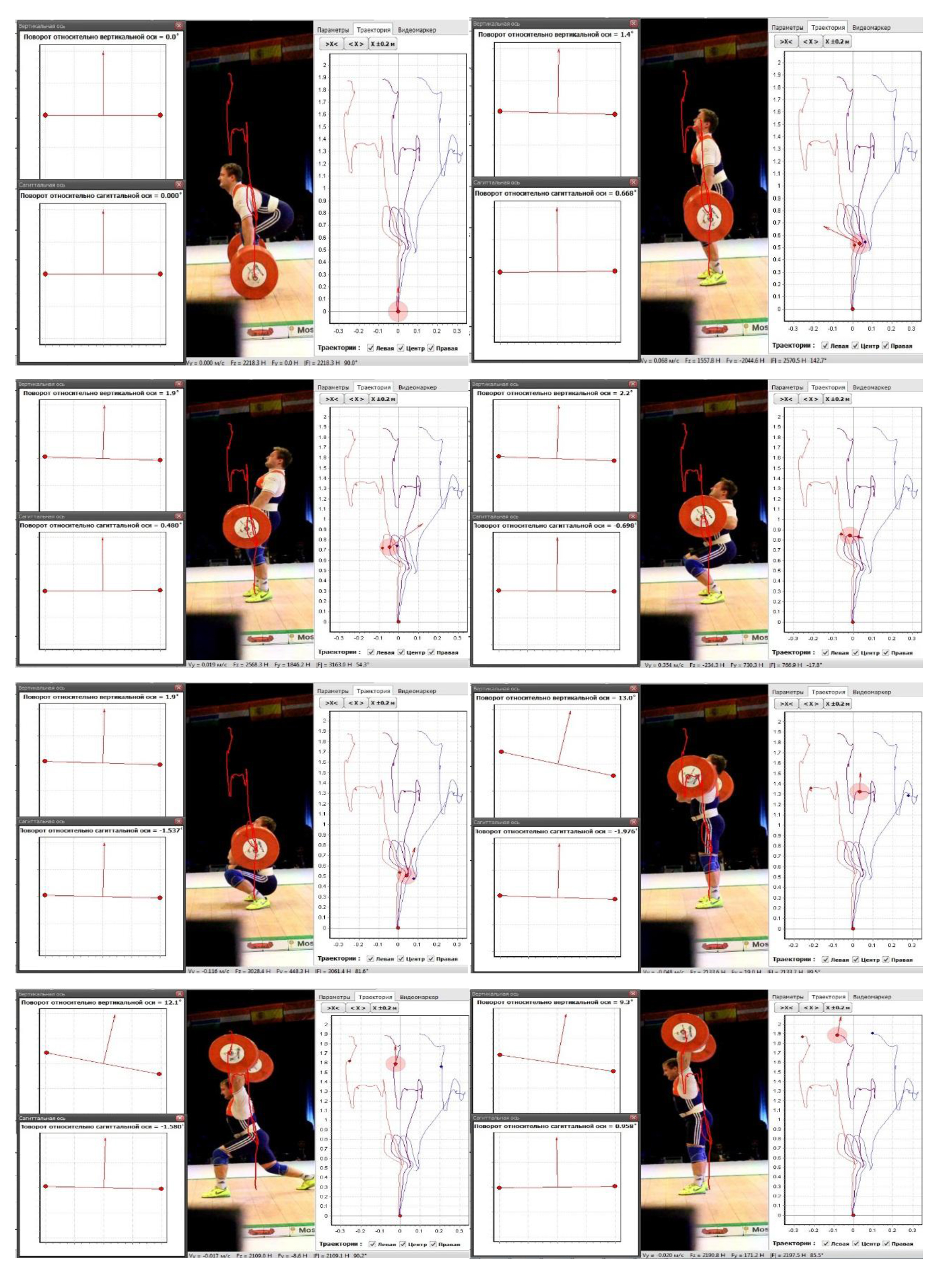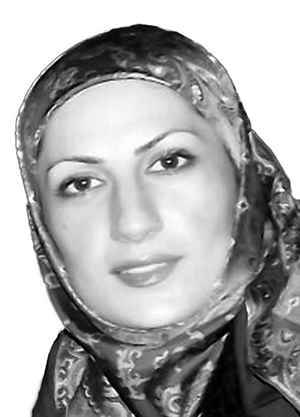Asymmetry of strength-speed capabilities in knee muscles and movement in clean and jerk in highly-skilled weightlifters
Фотографии:
ˑ:
PhD Masoumi Shahrzad
Dr.Hab., Professor A.A. Shalmanov
PhD, Professor E.A. Lukunina
1 Islamic Azad University of Rasht, Iran
2 Russian State University of Physical Culture, Sport, Youth and Tourism, Moscow
Keywords: symmetry and asymmetry, strengthspeed capabilities, weightlifting.
Introduction. Numerous works of Russian [3, 4, 5, 6] and foreign [7, 8] researchers are devoted to studies of motor asymmetries in sport. It is important to study functional asymmetry and lateral preferences from both theoretical and practical points of view. They influence sport performance and injury rates. For this reason, further studies of functional asymmetry in representatives of different sports and its effect on various aspects of physical activity are of great importance.
In weightlifting, the problems of asymmetry in the athletes' body structure and topography of muscle strength are particularly important because when lifting weights, many athletes rotate with the bar around vertical axis and as a consequence, which frequently results in a failure. One of the main reasons is the asymmetry in strength capabilities and joint flexibility of athletes.
Objective of the research was to study specific group and individual changes in the indicators of asymmetry of strength-speed capabilities of the knee muscles and weightlifting movements in classic exercises.
Methods and organisation of the research. The study included two experiments. The goal of the first experiment was to investigate specific individual and group in the indicators of asymmetry of strength-speed capabilities of the knee extensor and flexor muscles for both legs. The strength-speed of these muscles were estimated using the multifunctional isokinetic dynamometer «Biodex System-3». The joint movement was performed at 240о/s with torque determined during muscle contraction in the overcoming mode. To estimate the asymmetry two indicators were used. The first one was the coefficient of lateral asymmetry, defined as the ratio of the torque values for the right knee extensor and flexor muscles to those of the left knee. The second one - the coefficient of antagonist muscles asymmetry (Coant), defined as the ratio of the torque values for the knee extensor muscle to the knee flexor muscle of both legs.
6 weightlifters participated in this experiment: the mean body weight - 85,2 ± 11,7 kg, the mean height, 1,76 ± 0,048 m and the mean age, 21,7 ± 3,14 years.
The second experiment was related to the study of the asymmetry in the athlete’s movements while performing classical exercises which results in the rotation of the bar in the vertical (α) and the sagittal (β) axes which go through the center of projectile’s mass. The angles of rotation of the bar head with respect to these axes were used as the indicators of asymmetry. Angular coordinates were measured at the following moments:
1- Starting position (angle equal to zero);
2- End of pre-acceleration phase (α1, β1);
3- Maximum vertical speed at final acceleration (α2, β2);
4- Maximum height in a snatch (α3, β3);
5- Clean (α4, β4);
6- Start of jerk (α5, β5);
7- End of jerk (α6, β6);
8- Fixation of the bar at the end of the exercise (α7, β7).

Figure 1. The trajectory of GCM and the ends (right and left) of the bar in clean and jerk
The bar movement was registered using the method of study of technical and speed-strength abilities of weightlifters "GTSOLIFK 2012 "[1, 2]. The research tools included two Canon photo-cameras synchronized to other devices. Passive markers were fastened at both of the ends of the bar. Video cameras were placed on both sides of the weightlifting platform 7.5 m from the end of the bar. The optical axes of the cameras were directed perpendicular to the shooting plane at a height of 1.2 m from the surface of the platform. The frame rate was 50 frames per second. The shooting was conducted during the competition at the 2013 Russian President's Cup in Mytishchi.
The best attempts of 10 elite heavyweight representatives in clean and jerk were processed (mean body weight - 119,2 ± 20,4 kg, mean height - 1,83 ± 0,050 m, mean age - 25,9 ± 5,0 years, mean result in clean and jerk - 221,4 ± 10,1 kg). Example of video processing results is shown in Figure 1.
Results
First experiment:
Tables 1 and 2 show the mean and individual values of torque and the asymmetry coefficients of strength capabilities in the knee flexor and extensor muscles.
Table 1. Mean values and indicators of maximum torques and asymmetry coefficients of knee antagonist muscles in weightlifters (n = 6)
|
Variables |
Mean & STD |
Coant |
||
|
Torque (Nm) |
Right leg |
Extension |
200,1±52,31 |
1,69±0,39 |
|
Flexion |
105,1±17,69 |
|||
|
Left leg |
Extension |
184,8±39,35 |
1,67±0,15 |
|
|
Flexion |
111,0±20,35 |
|||
Table 2. Individual values of maximum torque (Nm) during knee extension and flexion
|
Participants |
Extension |
Flexion |
Coant Right |
Coant Left |
||||
|
Right |
Left |
CoLat |
Right |
Left |
CoLat |
|||
|
1 |
172,7 |
158,4 |
1,09 |
101,7 |
109,8 |
0,93 |
1,26 |
1,44 |
|
2 |
145,9 |
170,2 |
0,86 |
97,0 |
106,8 |
0,91 |
1,50 |
1,59 |
|
3 |
203,4 |
190,5 |
1,07 |
118,0 |
113,5 |
1,04 |
1,72 |
1,68 |
|
4 |
265,6 |
253,8 |
1,05 |
123,0 |
139,1 |
0,88 |
1,35 |
1,82 |
|
5 |
153,5 |
140,8 |
1,09 |
75,2 |
76,7 |
0,98 |
2,04 |
1,84 |
|
6 |
259,4 |
194,9 |
1,33 |
115,4 |
119,9 |
0,96 |
2,25 |
1,63 |
Comparison of the mean values of the asymmetry coefficients shows that the weightlifters' strength-speed capabilities for the right and left legs are almost identical. Similar asymmetry refers to the ratio of strength-speed indicators for the antagonist muscles of the right and left legs, since similar asymmetry coefficients are close to 1, 1.08 and 0.96 - for right and left leg muscles respectively.
As seen from analysis of individual indicators of asymmetry (Table 2), marked asymmetry is observed in the strength-speed indicators of the knee extensor and flexor muscles in some athletes. Accordingly, asymmetry can be estimated only using an individual approach.
References
- Matova M.A. Funktsional’naya asimmetriya i simmetriya prostranstvennogo vospriyatiya u sportsmenov raznykh spetsial’nostey (Functional asymmetry and symmetry of spatial perception in athletes of different specializations) / M.A. Matova, E.L. Berezhkovskaya // Teoriya i praktika fizicheskoy kultury. – 1980. – № 11. – P. 6–9.
- Fomin E.V. Issledovaniya topografii myshechnoy sily voleybolistov (Research topography of muscular strength of volleyball players) / E.V. Fomin // Teoriya i praktika fizicheskoy kultury. – 1986. – № 8. – P. 37–39.
- Chermit K.D. Dialektika simmetrii i asimmetrii v teorii sportivnoy trenirovki (Dialectics of symmetry and asymmetry in sports training theory) / K.D. Chermit // Teoriya i praktika fizicheskoy kultury. – 1994. – № 8.– P. 29–32.
- Chermit K.D. Simmetriyaasimmetriya v sporte (Symmetryasymmetry in sport). – Moscow: Fizkul’tura i sport, 1992. – 255 P.
- Shalmanov A.A. Metodika registratsii postupatel’nogo i vrashchatel'nogo dvizheniya shtangi (Technique of detecting translation and rotational modes of bar motion) / A.A. Shalmanov, V.F. Skotnikov, A.P. Bayurin // Teoriya i praktika prikladnykh i ekstremal'nykh vidov sporta. – 2014. – № 4. – P. 30–34.
- Shalmanov A.A. Biomekhanicheskiy kontrol’ tekhnicheskoy i skorostnosilovoy podgotovlennosti sportsmenov v tyazheloy atletike (Biomechanical control of technical and speedstrength capabilities of weightlifters) / A.A. Shalmanov, V.F. Skotnikov // Teoriya i praktika fizicheskoy kultury. – 2013. – № 2. – P. 103–106.
- Smack W. The influence of pedaling rate on bilateral asymmetry in cycling / W. Smack, R.R. Neptune, M.L. Hull // J. Biomech. – 1999. – Vol. 32, N 9. – P. 899906.
- HansJoachim M. Identification of bilateral asymmetries in lower limbs of soccer players by vertical jumps on a double force platform / M. HansJoachim, H.C. Mauro, L. Gisele // XXIV ISBS Symposium 2006, Salzburg – Austria.
Corresponding author: Sh-masoumi@hotmail.com



